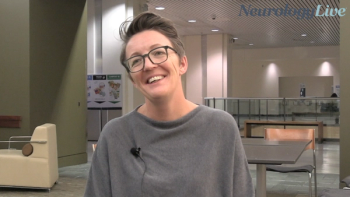
Evolution of MS MRI Guidelines and Alignment With MAGNIMS

June Halper, MSN, APC-C, MSCN, FAAN: Welcome to this NeurologyLive® Peer Exchange discussion. I am joined by a panel of my colleagues, all experts in the field of multiple sclerosis. We are very excited to discuss highlights from our internationally attended Consortium of MS Centers meeting held recently defining updates to the MRI protocol and clinical guidelines.
I am June Halper, a certified nurse practitioner and CEO of the Consortium of Multiple Sclerosis Centers.
And I’m joined today by a distinguished panel:
On my left is Dr Frederik Barkhof, a professor of neuroradiology at the VU University Medical Centre in Amsterdam, Netherlands, and the Queen Square Institute of Neurology in London, University College London;
On my left again is Dr David Li, professor of radiology at the University of British Columbia in Vancouver, Canada;
Dr Scott Newsome, to my right, is an associate professor at Johns Hopkins University School of Medicine and president-elect of the CMSC;
And finally, last by not least, Dr Tony Traboulsee is a professor of neurology at the University of British Columbia in Vancouver.
Thank you so much for joining us today, and let’s begin. Tony, please tell us why and how this all started, and why we needed this meeting recently.
Anthony Traboulsee, MD, FRCPC: Thanks, June. It’s a pleasure to be here. Imaging using MRI [magnetic resonance imaging] has been one of the most important tools in diagnosing and following patients with multiple sclerosis. It gives us a much better idea of how the disease evolves. My former mentor, Don Paty was one of the early pioneers of using MRI to understand and diagnose patients with multiple sclerosis. Early on he recognized that there was a need to use this tool practically for clinicians and to take what we learned in research and adapt it to clinical practice to make it a broadly used technique. Over the past 2 decades, we’ve been working on evolutions of these guidelines and a protocol that is easy to use in clinical practice, gives the necessary information, but more importantly provides reliable data over time. If we’re making treatment decisions and diagnostic decisions based on imaging, we need good quality data, so that we can compare studies over time to detect this clinically silent disease.
The guidelines reflect the evolution of technology, the evolution of knowledge around how MS [multiple sclerosis] is developing, so that we have the best care possible for patients with MS. An international group of colleagues around the world have been contributing to the development of protocols, and this was a great opportunity to meet again to see where we’re at in terms of the technology and to see how we can improve the guidelines even further.
June Halper, MSN, APC-C, MSCN, FAAN: David, who was at the meeting?
David Li, MD, FRCPC: Well, this meeting we had the people who have gathered in the past, neurologists and radiologists who are experts in the field of multiple sclerosis. But, additionally, for this particular meeting, we were fortunate enough to gather together people from industry, people who make the MRI scanners and also take the information from the MRI scanners to process them to produce quantitative measures. We also had representatives from the National Multiple Sclerosis Society and the Multiple Sclerosis Association of America. It was a group that was able to talk about the guidelines but also help us try to disseminate and implement these guidelines. That was why we thought it was important to particularly bring the vendors aboard so that they could help us with what we needed to do.
June Halper, MSN, APC-C, MSCN, FAAN: Yeah, it was great. When we first started, Fred, years ago, we were it. Now, of course, it’s become an international effort. I understand you’re involved with MAGNIMS [Magnetic Resonance Imaging in Multiple Sclerosis] in Europe, and I’m so pleased you were able to come over. How do you see this process evolving in terms of trying to align this internationally, and do you think that might happen?
Frederik Barkhof, MD, PhD: I would hope so because I don’t think that MS is fundamentally a different disease in Europe, where I come from, and where the MAGNIMS Network is active or in the United States, Canada, or even outside those regions. Our own group, the MAGNIMs group, has been working on issuing guidelines on how to best perform scans but also to think of what part of the central nervous system to image and when to image. These are evolving things because the demands are also changing. In the past it was mostly focused on diagnosis and increasingly it’s about monitoring treatment and making treatment decisions, picking up safety signals. Meanwhile, the machines are changing, so they have to take advantage of that without being carried away too much. I had the pleasure to already contribute to a previous iteration of the CMSC [Consortium of Multiple Sclerosis Centers] guidelines, I believe, in 2006… and vice versa, there’s been cross fertilization with the MAGNIMS group. We obviously read one another’s guidelines. It’s good to see that this is getting closer together, and it’s great to collaborate between North America and Europe.
Anthony Traboulsee, MD, FRCPC: I think one of the challenges we’ve had is trying to determine if we are developing a research protocol or guidelines versus clinical practice guidelines. I think the MAGNIMS group has really been focused on clinical practice as well.
Frederik Barkhof, MD, PhD: Yes. It is originally a research network, so we do a lot of collaborative research projects and we review evidence about new avenues of research, disease, and science. But we also try to make a difference in clinical practice for patient care. You often have to compromise. There are things that we do in our research studies which I would love to translate to clinical practice, but they’re often difficult to implement. So you have to be realistic and ..... develop protocols that can be used everywhere, is well interpreted, and doesn’t get carried away too much by fancy sequences.
Newsletter
Keep your finger on the pulse of neurology—subscribe to NeurologyLive for expert interviews, new data, and breakthrough treatment updates.



































